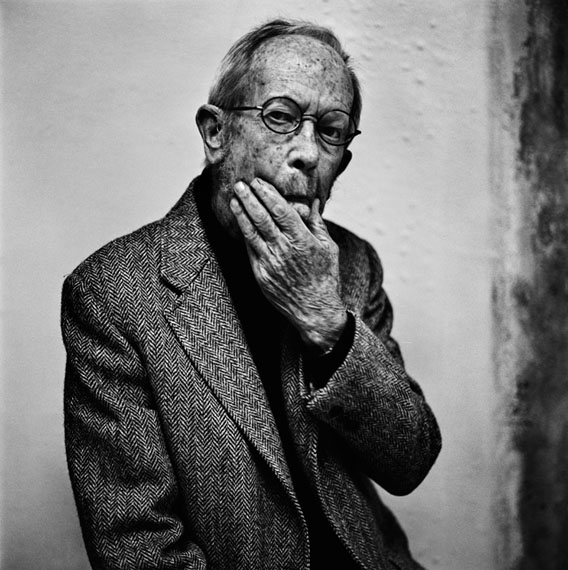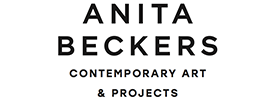
Galerie Anita Beckers | Frankfurt
Unseen Photo Fair 2014
Booth
Anton Corbijn » Christiane Feser » Achim Hoops » Clare Langan » Dierk Maass »
Exhibition: 18 Sep – 21 Sep 2014
Unseen Photo Fair
Westergasfabriek
Amsterdam

Galerie Anita Beckers
Braubachstr. 9
60311 Frankfurt (Main)
+49 (0)69-92101972
info@galerie-beckers.de
www.galerie-beckers.de
Tue-Fri 11-18, Sat 12-17
On occasion of the Unseen photo fair, Galerie Anita Beckers showcases works never exhibited before by Anton Corbijn (NL), Christiane Feser (DE), Achim Hoops (DE),Clare Langan (IE), and Dierk Maass (CH).
The ambitious character of the fair allows to juxtapose the work of both undiscovered talents and established artists. World-renowned multi-talented photographer, music video and filmmaker Anton Corbijn (*1955, Strijen) remains faithful to his original love: black & white photography. His photographic portrait of Elmore Leonard (2011) is imbued with values of an almost religious nature, a consequence perhaps of being raised as the son of a Calvinist priest. The strength of his photography lies exactly in the delicate balance it performs. These images look authentic, serious and yet humorous, spontaneous and yet perfect, they exude a sense of closeness and at the same time a sense of coolness with the portrayed. It is this energy propelled by such contradictory forces,that makes them memorable.
Recently acquired by the Guggenheim in New York, Christiane Feser's (*1977, Würzburg) work has attained several recognitions, including the Cité Internationale des Arts in Paris (2013). Feser explores three-dimensional folding and cutting paper techniques through the photographic medium. Her minimal physical paper constructions lend shape to complex abstract photographic landscapes, by reworking them manually and rephotographing them over and over. Intensely optical, the outcome defies medium categorization and reminds us of constructivism and architecture. Light and shadow, the materiality of the paper, lens distortions, chromatic aberrations, and the aging process of a photograph all play a role in this investigation about the limits of the photographic medium.
Extensively awarded, Clare Langan’s (*1967, Dublin) video work often deals with mankind’s fragility when exposed to the overwhelming forces of nature. Her newest film ‘The Floating World’ (2013) shows a phantasmagorical abandoned city, in a direct reference to todays’ progress and financial profit downfall. The film takes on a gloomy reflection on our current economic chaos by suggesting an inevitable connection between human pursuit and the decline of civilisation. The current presentation focuses on ‘The Floating World’ photos, which originated during the filming process, in parallel to it, and not from video stills. The display as triptychs, relates to the fact that the film was shot in three distinct locations, very different in terms of geography, history and symbolism.
Achim Hoops’ (*1953, Hamburg) digital drawings render nocturne images of deserted places taken from the cinema or the news. Staircases, corners, roads, shop windows, walls and parked cars become his main subject. An intense light and shadow play becomes a metaphor for waking and dreaming, for remembering and forgetting. Seemingly enigmatic, we persist in finding a narrative for these scenes, to explain them and try and fill the void they leave in us. With its chiaroscuro lighting, geometric orderly settings and quiet mood, these fictional spaces acquire new aesthetic and cinematic qualities and transform our notion of reality. These computer-made drawings might well be a reaction to the advances of technology nowadays.
Throughout the past 30 years, photography has accompanied Dierk Maass’ (*1943,Hildesheim). Born out of his amazement with the exploration of remote places, his credo can be resumed as to wanting “to capture the magic of the remotest regions of the world, whenever the eye is taken by visual sensations.” In search of a utopian mirage of deserted inhospitality, Maass has travelled the world with his camera, from the Andes to Antarctica, the Alps to Alaska. In Shades° of Dolpo, Maass shows a world, which until 1993, only a few foreigners had access to. These over-dimensioned portraits of young children and of old people speak about the passage of time in personal history. With this series Dierk Maass questions the role of the photographer: an engaged ethnographer or a passive witness to human beauty?�